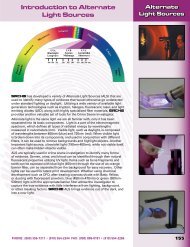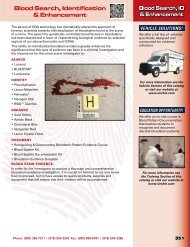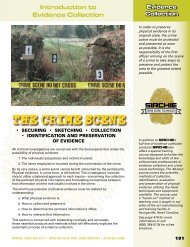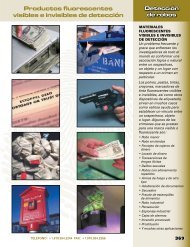Liquid Silicone Rubber - Sirchie
Liquid Silicone Rubber - Sirchie
Liquid Silicone Rubber - Sirchie
You also want an ePaper? Increase the reach of your titles
YUMPU automatically turns print PDFs into web optimized ePapers that Google loves.
TI02-109ENG-REV4<br />
SIRCHIE<br />
Products • Vehicles • training<br />
TECHNICAL INFORMATION<br />
<strong>Liquid</strong> <strong>Silicone</strong> Casting Kit<br />
Catalog No. 640C<br />
INTRODUCTION<br />
Footwear identification has advanced in recent years from a mere aid to investigation to an<br />
accepted laboratory technique on a level with ballistics and fingerprint examinations. Not<br />
long ago, footwear evidence was acceptable only as supporting or corroborative—but<br />
not sufficient proof in itself. However, in the past three<br />
decades, court rulings have increasingly accepted footwear evidence<br />
as positive proof of presence, even in the most serious of offenses.<br />
This bulletin describes the use of <strong>Liquid</strong> <strong>Silicone</strong> <strong>Rubber</strong> and the other<br />
components in the 640C Casting Kit. <strong>Liquid</strong> <strong>Silicone</strong> <strong>Rubber</strong> may be<br />
used for foot, tire and tool mark impressions.<br />
CAUTION<br />
• Before using this kit, consult the appropriate Material Safety Data<br />
Sheets (MSDS) found on our website at www.sirchie.com/support.<br />
Copyright© 2010 by SIRCHIE<br />
All Rights Reserved.<br />
100 HUNTER PLACE, YOUNGSVILLE, NC 27596 USA<br />
Ph: (919) 554-2244, (800) 356-7311 • Fax: (919) 554-2266, (800) 899-8181 • Web: www.sirchie.com • Email: sirchieinfo@sirchie.com<br />
1 of 4
TI02-109ENG-REV4<br />
PROCEDURE<br />
All impressions, whether they are of footwear, tires, or tool marks, should be photographed before an attempt<br />
at casting is made.<br />
First, the casting frame (FCF100 or FCF200) should be placed around the impression area unless the impression<br />
is too small to warrant it. Foreign matter such as twigs, leaves, etc. should be removed with care not<br />
to damage any detail before applying the hardener or base builder. DO NOT remove any debris imbedded<br />
in the impression. The impression area can then be prepared for the casting compound by applying Dust<br />
and Dirt Hardener (638C32).<br />
The <strong>Silicone</strong> <strong>Rubber</strong> Release Agent (SRA10) is applied lightly to the impression area after adequate setup<br />
time of the Dust and Dirt Hardener, if used, has been observed.<br />
After initial preparations are completed, the <strong>Silicone</strong> <strong>Rubber</strong> Mixture (<strong>Rubber</strong>, Thinner and Catalyst) is<br />
gently poured into the impression until the entire impression area is filled. After hardening is complete<br />
(about 15 minutes), remove the cast. Note: The casting removed from the original impression is a negative<br />
(mirror image) of the impression.<br />
KIT COMPONENTS<br />
<strong>Liquid</strong> <strong>Silicone</strong> <strong>Rubber</strong> (634C)<br />
A free-flowing, white rubber-based material. After the addition of a Catalyst, the material<br />
is poured into the desired location, and it will fill all indentations and crevices in minute<br />
detail. Before adding the catalyst, stir the <strong>Silicone</strong> <strong>Rubber</strong> well, as it settles in storage. This<br />
base is workable for 1-2 minutes and will be tack-free in 30 minutes.<br />
When making larger castings (i.e., full foot or tire impressions), the <strong>Silicone</strong> <strong>Rubber</strong> base<br />
may be thinned as much as one part rubber to one part thinner (1:1). For tool marks and<br />
other small impressions, the <strong>Silicone</strong> <strong>Rubber</strong> does not need to be thinned. The recommended<br />
mixture for foot and tire impressions is: 1 lb. (454g) jar of <strong>Liquid</strong> <strong>Silicone</strong> <strong>Rubber</strong> (634C);<br />
2 of 4
3 of 4<br />
TI02-109ENG-REV4<br />
1 lb. (454g) jar of 636C Thinner; and 1 vial of <strong>Silicone</strong> Catalyst (TM1). NOTe: Stir <strong>Silicone</strong> <strong>Rubber</strong> and<br />
Thinner well before adding the Catalyst.<br />
<strong>Silicone</strong> Catalyst (TM1)<br />
This material is used to catalyze the <strong>Liquid</strong> <strong>Silicone</strong> <strong>Rubber</strong>. Add one part Catalyst to 200 parts of the<br />
<strong>Liquid</strong> <strong>Silicone</strong> <strong>Rubber</strong> by weight (1:200). Generally, use 1 lb. (454g) of <strong>Liquid</strong> <strong>Silicone</strong> <strong>Rubber</strong> to 1 vial<br />
of Catalyst. When using smaller quantities, proportionate measurement is used (1:1—i.e., 1/4 jar of <strong>Liquid</strong><br />
<strong>Silicone</strong> <strong>Rubber</strong> to 1/4 vial Catalyst). This proportion holds true whether or not Thinner has been added.<br />
Caution: Catalyst may cause skin irritation —handle with care.<br />
<strong>Silicone</strong> <strong>Rubber</strong> Thinner (636C)<br />
The Thinner is an inert <strong>Silicone</strong> fluid used to lower the consistency of the <strong>Liquid</strong> <strong>Silicone</strong><br />
<strong>Rubber</strong>. Adding 10% Thinner reduces the consistency of the <strong>Silicone</strong> <strong>Rubber</strong> base to 1/4 the<br />
original compound without causing significant change in working time or the catalyzed rubber<br />
base or the ultimate physical properties of the cured rubber. Addition of more<br />
than 10% of Thinner elevates the setup time accordingly. Mix the Thinner<br />
with the <strong>Silicone</strong> <strong>Rubber</strong> Compound, stirring well. Next, add the Catalyst in<br />
the recommended proportion.<br />
Dust and Dirt Hardener (638CA)<br />
Dust and Dirt Hardener is utilized when casts are to be made of impressions in sand or<br />
soft soil. Place the casting frame (FCF100 or FCF200) around the impression and spray<br />
3-4 light coats of Hardener into and around the impression. DO NOT spray directly at the<br />
impression, but rather in a manner that allows the Hardener to fall into the impression as a<br />
mist. Spraying directly at the impression under elevated pressure will disturb the impression<br />
characteristics. Allow at least 2-3 minutes between each coat of Hardener. Normally 3-4<br />
coats will be sufficient.
TI02-109ENG-REV4<br />
When preparing impressions in snow, we recommend the use of Snow Impression Wax<br />
(SP100). The Gas Power Unit (637C1) should have 638Y Spray Head Cleaner run through<br />
after use. Follow instructions on using the Gas Power Unit.<br />
<strong>Silicone</strong> <strong>Rubber</strong> Release Agent (SRA10)<br />
This release agent is used to aid in separation of the set rubber from the impression<br />
area before pouring the catalyzed casting compound into it. It should<br />
be used 10 minutes after application of the Dust and Dirt Hardener. DO NOT<br />
hold the nozzle too close in order to avoid wetting the impression area. A light<br />
coating is sufficient.<br />
640C CONTENTS:<br />
2- 634C <strong>Liquid</strong> <strong>Silicone</strong> <strong>Rubber</strong>, 1 lb. (454g)<br />
1- 636C <strong>Silicone</strong> <strong>Rubber</strong> Thinner, 16 oz. (473ml)<br />
2- TM1 Vials of Catalyst<br />
1- SRA10 Aerosol <strong>Silicone</strong> <strong>Rubber</strong> Release Agent, 4.5 oz.<br />
(133ml)<br />
1- KCP142 Steel Spoon<br />
1- KCP155 Spatula, 7" (17.8cm), Steel Blade<br />
1- 642C Flexible Mixing Bowl, 4.25" (10.8cm)<br />
1- 643C Flexible Mixing Bowl, 4.75" (12.1cm)<br />
1- 644C Flexible Mixing Bowl, 5.25" (13.3cm)<br />
1- SP1000 Snow Impression Wax, Net Wt. 15 oz. (425g)<br />
2- 639C4 Base Builder, 8 oz. vol. (236ml)<br />
4 of 4<br />
1- 638CA Aerosol Dust & Dirt Hardener, Net Wt. 15 oz.<br />
(425g)<br />
1- SK900 Tape Measure, English/metric, 100 ft. (30m)<br />
25- 608E01 Evidence Tags w/Ties<br />
1- KCP200 Surface Brush<br />
1- FCF100 Adjustable Casting Frame, 7.25" x 12"-18" (18.4cm<br />
x 30.5cm-45.7cm)<br />
1- Technical Instructions<br />
1- 640CC Black Molded Copolymer Carrying Case w/<br />
Folding Handle and Locking Latches, Includes Molded<br />
Inserts; Dimensions: 17" x 13" x 7.375" (43.2cm x 33cm x<br />
18.7cm); Weight: 16.5 lbs. (7.5kg)








